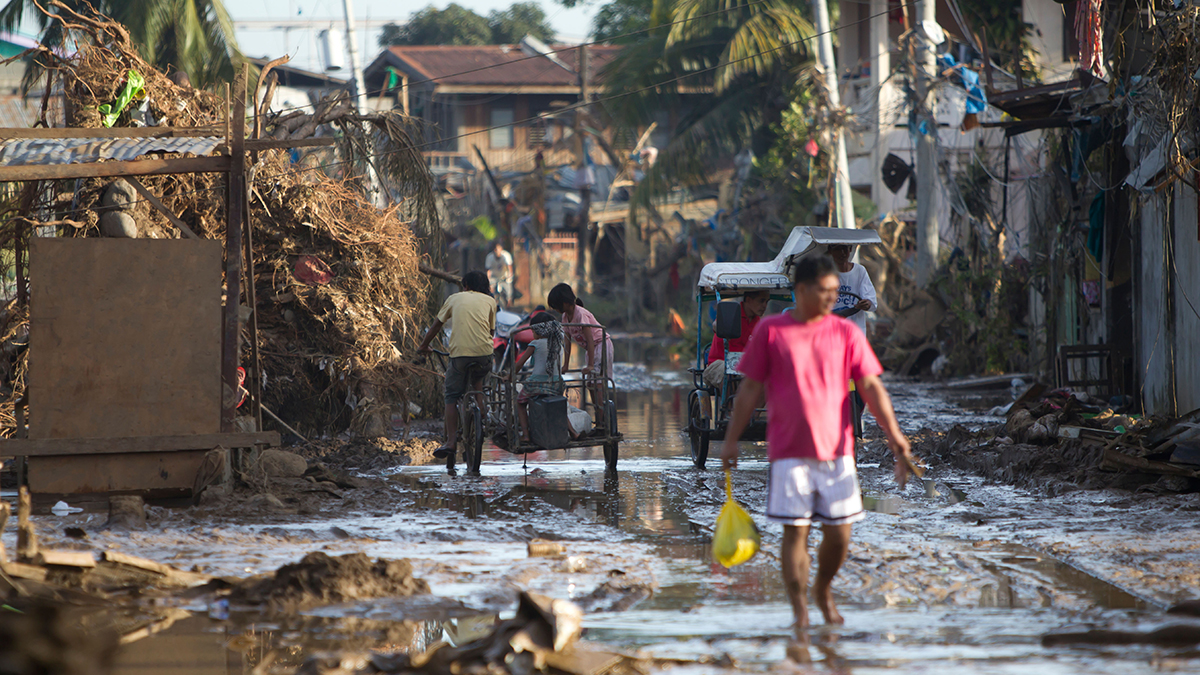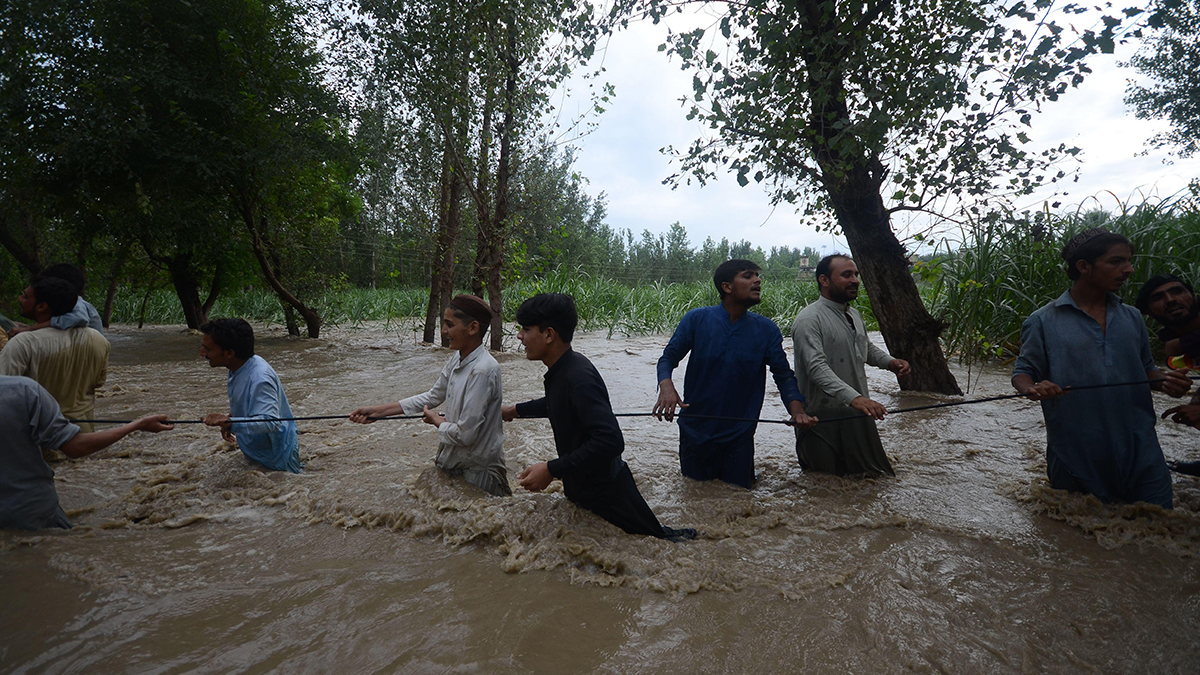Insurers must help accelerate pre-arranged finance for disasters: Clarke
‘We need to shift the discussion away from, ‘Look, there’s a disaster, let’s help’, to ‘There’s disaster risk, let’s help’, the director of the UK’s Centre for Disaster Protection, Daniel Clarke, says
By 2050, only 20% of international crisis finance will be pre-arranged, which is 20 years too late, head of the Centre for Disaster Protection says
There is a meaningful role for insurers to play in accelerating the development of ex ante responses to crisis financing, but only if they can demonstrate humility for the context they would be entering, according to Daniel Clarke, director of the Centre for Disaster Protection (CDP).
In an interview with Insurance Day, Clarke stresses only 2.7% of global crisis finance is currently pre-arranged. Quoting from a new UK government white paper on international development, he says this “can and should be much higher”.
The report by the UK Office for Foreign, Commonwealth & Development Affairs – International development in a contested world – underscores the importance of pre-arranged financing (PAF) to help build resilience and enable adaptation for those affected by conflict, disasters and climate change.
The white paper recognises PAF, including insurance, is part of the UK’s humanitarian toolkit, closely linked to climate adaptation and resilience. It also emphasises the use of climate-resilient debt clauses by all creditors to ensure fiscal resilience to natural disasters and pandemics.
“A substantial proportion of crises and disasters are risks that are modellable, which means we needn’t have waited. It’s possible to know a cyclone, a drought, a flood has a certain risk and it would be possible therefore to arrange financing in advance through insurance or other kinds of PAF”
Daniel Clarke
Centre for Disaster Protection
The CDP’s work in support of the International Federation of Red Cross and Red Crescent Societies’ disaster response emergency fund (DREF) is featured as a case study in the white paper, showcasing innovative public-private initiatives developed in collaboration with Aon and Lloyd’s Disaster Risk Facility. Launched in September, this is a groundbreaking financial mechanism to transform disaster response by providing a backstop for DREF.
“When it comes to disasters and crises there is, and has been for a long time, a natural solidarity around the world towards the people who have been affected, but the question now is, how can we be most effective,” Clarke says.
This question is addressed in the latest edition of the CDP’s report, The state of pre-arranged financing for disasters, in which it says only 2.7% ($1.9bn) of the $71bn in international crisis financing in 2021 was pre-arranged.
Clarke says: “Extrapolating from the five years of data to 2021 shows about 20% of all international crisis finance will be pre-arranged by 2050, so it’s increasing but we need to accelerate and get to 20% by 2030. Alongside that, we also need to make sure what we’re investing in is actually working.”
Low-income countries miss out
Another revealing statistic is just 3.7% (about $200m) of international development financing for PAF had reached low-income countries. In other words, across the period 2017 to 2021, high-income countries received the highest levels of international development financing for PAF per capita ($12.4) and low-income countries the lowest (30¢).
Insurance is one type of PAF, which can also take the form of, for example, contingent loans and catastrophe bonds. “A substantial proportion of crises and disasters are risks that are modellable, which means we needn’t have waited,” Clarke says. “It’s possible to know a cyclone, a drought, a flood has a certain risk and it would be possible therefore to arrange financing in advance through insurance or other kinds of PAF.”
Ex-post financing of disasters is like “finding money down the back of the sofa”, he continues, whereas PAF should and could be provided for predictable risks.
Most PAF is in the form of contingent loans, many of which are going to countries that are not in, or near, debt distress. For lower income countries, most PAF comes via insurance pools, such as those in Africa and the Caribbean, that are owned by countries and provide parametric cover.
The parallel between PAF and insurance is clear, he stresses. “We need more disaster risk insurance to ensure no one is left behind.”
Clarke echoes recent remarks by the Insurance Development Forum (IDF) secretary-general, Ekhosuehi Iyahen, that the protection gap is not about charity, but instead about “creating new markets for an unprecedented era”.
Clarke says: “Insuring climate risk means the protection gap should not be about high-income countries teaching low-income countries. This is not a global north versus global south agenda. It is an agenda where we need humility.”
He continues: “There’s a long history in international development of outsiders trying to help but actually not helping, because they don’t understand the context, they don’t understand what’s needed and they’re not listening to people who know their own context and needs. If an insurance company is interested in pre-arranged financing, it needs to start from a position of humility and not immediately think it knows how to solve the problem. The IDF has been very active on the international policy agenda, both in terms of trying to make things happen in practice, as well as shaping the policy discourse, to shift the discussion away from, ‘Look, there’s a disaster, let’s help’, to ‘There’s disaster risk, let’s help’.”
Funded by the UK budget, the CDP was set up with humility as a “fundamental part of our philosophy”, Clarke adds. One-third of its team is from the insurance industry, the rest are experts in international development, humanitarian aid and delivery systems.
“We’ve got a real melting pot that’s designed to challenge each other constructively to achieve better solutions,” he says. “When solutions fail, it tends to be when one of those groups is not being listened to.”
Parametric problems
Failure by insurers can sometimes come from over-confidence in their use of technology.
“With parametric triggers, it’s easy to be confident about your models without ever having validated them and without ever having stood in the country you’re talking about or even spoken to somebody who lives in that region. And that’s a real issue. Insurers would never make that mistake with their personal lines products, designing something without first having spoken to somebody who might buy it.”
Another example is the use of satellite data. Clarke says: “I don’t think we need more satellites and I’m not sure we’re using remote sensor data in the best possible way. It’s not so much around the satellites and collecting information, but how we’re validating those indices.”
About a decade ago, Clarke was working in northern Kenya, where international experts in satellite data were trying to promote their parametric insurance products. They did that, he says, without listening to Kenya’s own experts at its national drought management authority, who understood the geography, as well as the livelihoods of the people in those areas.
“Parametric is a branding – ‘it’s not indemnity insurance’ – and there’s been a lot of debate over whose fault is it if the insurance product goes awry. A government might think it’s protected against drought but then the ‘wrong kind’ of drought happens. Whose fault is it then?”
Daniel Clarke
Centre for Disaster Protection
“Northern Kenya has acacia trees, which are green all year round. If the satellite data just looks at how green the land is, without accounting for the greenness of these trees, you end up with triggers not actually capturing the dry years. The government of Kenya stopped buying insurance and hasn’t bought insurance of that kind since. That was a lesson in humility for the international experts who thought they knew better.”
Clarke’s background is as an actuary and economist. He has worked with more than 40 developing country governments to develop improved risk finance schemes in close collaboration with bilateral and multilateral development institutions and the private insurance and reinsurance industry. He recalls having himself to show humility.
“In supporting the Red Cross and Red Crescent transaction, I remember a discussion internally, at the very beginning, around indemnity products. And I remember saying, ‘That’s not going to work, it has to be parametric, we can’t do disaster insurance for global humanitarian risks on an indemnity basis’. I was pleased to have been proven wrong,” he says.
With parametrics, he warns against “copying and pasting”, saying: “Countries are different, they have different needs and I think there is a real need for innovation and experimenting, but it’s not about new technology. It’s about calibration and validation. It’s about the relationship between what your parametric index is saying and what the early warning system had been saying previously, what humanitarian appeals have been saying, or what the world food programme data on food insecurity, or child nutrition data have been saying. It’s not that we don’t have the technology, it’s that we need to make it fit for purpose.”
Information gaps
Trust is a two-way street, though, and insurers need to be prepared for potential gaps in the information they receive.
“Often, when it comes to governments buying things like insurance policies, there are strict rules around confidentiality and procurement. They’re there for good reason but they can also mean a government doesn’t always have the right group of people scrutinising what it is they’re buying,” Clarke says.
“For example, the agriculture ministry doesn’t always ask the finance ministry or the insurance regulator to provide input and buys something that may not be fit for purpose or buys an earthquake insurance policy without talking to its own centre of excellence on earthquake risk in the country.”
A debate is under way in the parametric insurance community, Clarke says, around the fact insurers have a responsibility to ensure information about their products is not misleading and they deliver fair outcomes, but parametric insurance is a derivative.
“Parametric is a branding – ‘it’s not indemnity insurance’ – and there’s been a lot of debate over whose fault is it if the insurance product goes awry,” he says.
“A government might think it’s protected against drought but then the ‘wrong kind’ of drought happens. Whose fault is it then? I think now there is much more the view it is a shared responsibility.”
Who polices that transparency?
“That’s a great question. The answer is, nobody,” Clarke says. “There are often questions around whether parametric insurance fits within a country’s insurance regulator’s remit. Over my 20 years working in this area, one of the things that has frustrated me the most is a collection of people, typically well intentioned, will go ahead with something without anyone in the process really having a look at it and providing the breadth of challenge needed.”
That was one of the reasons the UK government established the CDP in 2017.
Quality assurance
Clarke says: “One of the services we offer is quality assurance for any parametric insurance product for a developing country or for a humanitarian organisation. We will encourage our clients to make those quality assurance reviews available publicly or at least available to all the people who are financing the costs, so all the stakeholders buying into it understand what they’re buying and are provided with information that really helps them to make a decision.”
Humanitarian organisations often find it “difficult to articulate” what they need from insurers, he continues. “What we do in that context is try and bring everyone together across the public-private partnership, so they can have realistic expectations, and that both leads to better decisions at the purchasing stage, but also fewer regrets.”
There are countries in the developing world unused to asking for this type of support, however.
“I had a discussion with the previous finance minister for Ethiopia, who said, quite frankly, ‘We know about debt, I have teams in my ministry who already have expertise in working with commercial lenders, but we don’t have the equivalent for purchasing insurance’.”
For that reason, the CDP can directly promote its work to governments and international organisations, such as the African Development Bank, which in turn may recommend the CDP to a country in the form of a referral. Another example where the CDP may become involved is when international donors require the country they are funding pays a share of the cost.
Loss and damage financing
It is no coincidence the UK’s white paper on PAF has been published ahead of Cop28, which begins on November 30. Cop27 famously raised the “thorny issue” of loss and damage, Clarke points out, on which there has been slow movement for many decades.
“There is discussion around whether one component of loss and damage financing will be around event response, supporting people who have been affected by actual events in a specific way,” Clarke says.
An initiative launched at Cop7 by the G7 and V20 – the Global Shield against climate risks – is part of the “broader mosaic” of loss and damage financing, by supporting “high-quality, impactful pre-arranged finance”, he adds.
“As soon as you get into discussions around support for people who have been adversely affected, with relation to risks and shocks, you can’t avoid either insurance or insurance-like thinking.”
Another highlight of Cop27 was the launch of the Early Warnings For All Initiative by the UN secretary-general, Antonio Guterres. The initiative calls for the whole world to be covered by an early warning system by the end of 2027.
Is this relevant to pre-arranged finance?
“There are too many instances where early warning systems say ‘danger’, but that doesn’t lead to early action,” Clarke says, “so we really welcome the work of the early warnings for all initiative. What we work on is connecting that to finance, so it actually can be used to finance early action.”



